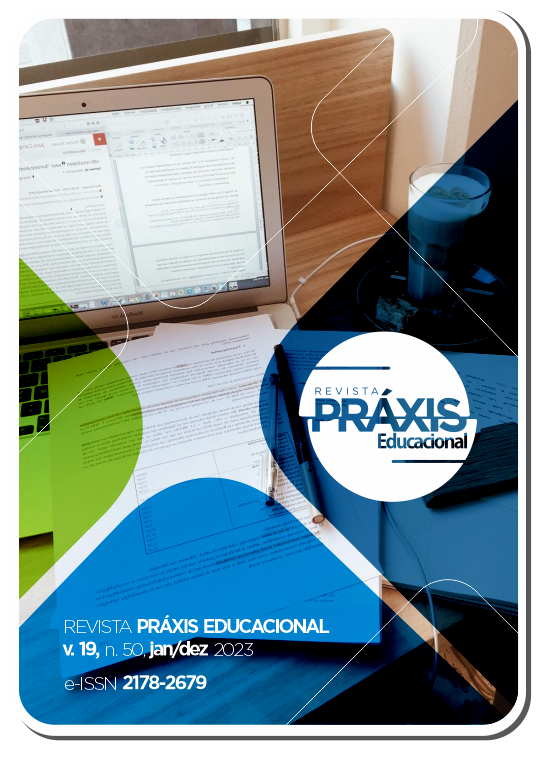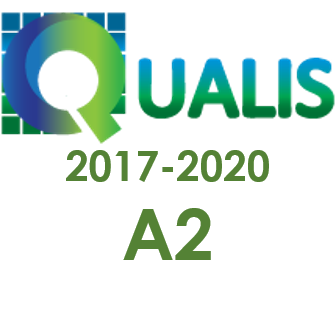Blended hands-on teaching: learning with more active students
DOI:
https://doi.org/10.22481/praxisedu.v19i50.11340Keywords:
active methodologies, curatorship, educational technologies, knowledge construction, reflectionAbstract
Blended learning has been described since the early 2000s as a combination of face-to-face and online educational activities. However, the focus of online activities, is centered on the use of videos that the teacher makes available and/or digital materials that the student finds on the internet. The question to be discussed is: how blended learning can create opportunities for the construction of knowledge? This article aims to present and discuss the hands-on approach of hybrid teaching, which incorporates the development of a product into the blended learning models. In addition to the product built by the student, the proposal emphasizes activities such as curation, reflection on the product built and conceptual deep dives. The methodology is based on documentary and bibliographic research, as well as on data collected in the participation of the live FuturED – LiveZAÇO Maker. The analysis of the articles and the collected data allow to conclude that merely creating a product does not necessarily indicate that the student has built knowledge based on this construction. Thus, curatorship, reflection and deep dives are fundamental to assist the student in the process of building conceptual knowledge based on hands-on activities.
Downloads
Metrics
References
ALMEIDA, Maria Elizabeth Bianconcini. Narrativa das Relações Entre Currículo e Cultura Digital em Tempos de Pandemia: uma experiência na pós-graduação. Práxis Educacional. Vitória da Conquista, v.17, n. 45, 2022. Disponível em: https://periodicos2.uesb.br/index.php/praxis/article/view/8324. Acesso em: 04 jan. 2023.
ALMEIDA, Maria Elizabeth Bianconcini; VALENTE, José Armando. Currículo e Contextos de Aprendizagem: integração entre o formal e o não-formal por meio de tecnologias digitais. Revista e-Curriculum (PUCSP), v. 12, n. 2, p. 1-27, 2014. Disponível em: http://revistas.pucsp.br/index.php/curriculum/article/view/20355. Acesso em: 04 jan. 2022.
ANJOS, Rosana Abutkka Vasconcelos; SILVA, Lídia Martins; ANJOS, Alexandre Martins. Ensino híbrido: organização e sistematização de conceitos com base em revisão sistemática da literatura. Em Rede: Revista da Educação a Distância, v. 6, n. 2, p. 203-220, 2019.
BACICH, Lilian; TANZI NETO, Adolfo; TREVISANI, Fernando de Mello (org.). Ensino híbrido: personalização e tecnologia na educação. Porto Alegre: Penso, 2015.
BELCHER, John W. Studio Physics at MIT. MIT Physics Annual, 2001. Disponível em: http://web.mit.edu/jbelcher/www/Belcher_physicsannual_fall_01.pdf. Acesso em: 01 jul. 2022.
BERGMANN, Jonathan; SAMS, Aaron. Flip Your Classroom: Reach Every Student in Every Class Every Day. Eugene, Oregon: ISTE, 2012.
BOGOST, Ian. The Condensed Classroom: "Flipped" classrooms don't invert traditional learning so much as abstract it. The Atlantic, 2013. Disponível em: http://www.theatlantic.com/technology/archive/2013/08/the-condensed-classroom/279013/. Acessado em: 9 ago. 2022.
CAVALCANTE, Vitor; KOMATSU, Bruno Kawaoka; MENEZES-FILHO, Naercio. Desigualdades Educacionais durante a Pandemia. Insper Centro de Gestão e Políticas Públicas. Policy Paper, n. 51, dezembro, 2020.
CHRISTENSEN, Clayton M.; HORN, Michael B.; JOHNSON, Curtis W. Disrupting Class: How Disruptive Innovation Will Change the Way the World Learns. New York: McGraw-Hill, 2008.
CHRISTENSEN, Clayton M.; HORN, Michael B.; STAKER, Heather. Ensino Híbrido: uma Inovação Disruptiva? Uma introdução à teoria dos híbridos. Maio de 2013. Disponível em: http://porvir.org/wp-content/uploads/2014/08/PT_Is-K-12-blended-learning-disruptive-Final.pdf. Acesso em: 01 jul. 2022.
DE LIMA, Ivonaldo Pereira; FERRETE, Anne Alilma Silva Souza; VASCONCELOS, Alana Danielly. Ensino híbrido como proposta de protagonismo discente. Humanidades & Inovação, v. 9, n. 5, p. 81-90, 2022. Disponível em: https://revista.unitins.br/index.php/humanidadeseinovacao/article/view/4292. Acesso em: 04 fev. 2023.
DIAS, Paulo. Cultura de inovação na educação a distância e em rede. Revista e-Curriculum, São Paulo, v.18, n. 4, p. 1733-1747 out./dez. 2020. Disponível em: https://revistas.pucsp.br/index.php/curriculum/article/view/50620. Acesso em: 26 jan. 2022.
DONOVAN, Lisa; ANDERBERG, Sahah. Teacher as Curator: formative assessment and art-based strategies. New York: Teachers College Press, 2020.
EYAL, Liat; GIL, Einat. Hybrid learning spaces – a three-fold evolving perspective. Preprint, 2021. Disponível em: https://www.researchgate.net/publication/353547179_Hybrid_learning_spaces_-_a_three-fold_evolving_perspective. Acesso em: 20 jan. 2022.
GIL, Antonio Carlos. Como Elaborar Projetos de Pesquisa. 4 ed. São Paulo: Atlas, 2006.
MARTINEZ, Sylvia L.; STAGER, Gary. Invent to learn: making, tinkering, and engineering in the classroom. Santa Barbara: Constructing Modern Knowledge Press, 2013.
MAZUR, Eric. Farewell, Lecture? Science, v. 323, p. 50-51, 2009.
MORAN, Jose. Ensino Híbrido: Não engessar o que ainda está em construção. Parte do Blog Educação transformadora. 2021. Disponível em: http://www2.eca.usp.br/moran/?p=2025. Acesso em: 05 jan. 2022.
NASCIMENTO, Maria Selma Lima do. Competências digitais dos professores na Paraíba/Brasil no cenário da pandemia do Covid-19. In DÍAZ, Inmaculada Aznar; RECHE, María Pilar Cáceres; MARÍN, José Antonio Marín; GUERRERO, Antonio José Moreno (org.). Desafíos de investigación educativa durante la pandemia COVID19. Madrid: Editorial Dykinson S. L., 2020, p. 78-88.
OLIVEIRA, Camila de Jesus; MARTINS, Priscila Monte Alegre; LOPES, Ana Lucia de Souza. Estratégias de Ensino Híbrido na Educação Infantil. São Bernardo do Campo: Ed. das Autoras, 2021. Disponível em: https://www.researchgate.net/publication/352492438_ESTRATEGIAS_DE_ENSINO_HIBRIDO_NA_EDUCACAO_INFANTIL. Acesso em: 05 jan. 2022.
ORGILÉS, Mireia; MORALES, Alexandra; DELVECCHIO, Elisa ; MAZZESCHI, Claudia; ESPADA, José P. Immediate psychological effects of the COVID-19 quarantine in youth from Italy and Spain. Front. Psychol, v. 11, 2020. Disponível em: https://www.frontiersin.org/articles/10.3389/fpsyg.2020.579038/full. Acesso em: 03 jan. 2022.
PIAGET, Jean. Recherches sur l'abstraction réfléchissante. Études d'épistemologie génétique. Paris: PUF, tome 2, 1977.
PIAGET, Jean. Fazer e Compreender. São Paulo: Edições Melhoramentos e Editora da Universidade de São Paulo, 1978.
QUEIROZ, Virgínia Coeli Bueno de. A experiência da aprendizagem remota: quanto tempo demais na tela? Colégio Loyola. 2020. Disponível em: https://www.loyola.g12.br/wp-content/uploads/2020/06/Artigo-tempo-de-tela-vers%C3%A3o-final-convertido.pdf. Acesso em: 08 ago. 2022.
REIMERS, Fernando M.; OPERTTI, Renato. Learning to Build Back Better Futures for Education: Lessons from educational innovation during the covid-19 pandemic. UNESCO International Bureau of Education Geneva, Switzerland, 2021. Disponível em: https://www.ibe.unesco.org/sites/default/files/resources/book_ibe_-_global_education_innovation_initiative.pdf. Acesso em: 08 ago. 2022.
SANTOS, Aline Diniz dos; SILVA, Júlia Kamers da. O impacto do isolamento social no desenvolvimento cognitivo e comportamental infantil. Research, Society and Development, v. 10, n. 9, 2021. Disponível em: https://rsdjournal.org/index.php/rsd/article/view/18218. Acesso em: 09 ago. 2022.
SILVEIRA, Ismar Frango. O papel da aprendizagem ativa no ensino híbrido em um mundo pós-pandemia: reflexões e perspectivas. Revista Brasileira de Aprendizagem Aberta e a Distância, v. 2, 2021. Disponível em: http://seer.abed.net.br/index.php/RBAAD/article/view/557. Acesso em: 06 jan. 2022.
STAKER, Heather; HORN, Michael B. Classifying K–12 blended learning. Mountain View, CA: Innosight Institute, Inc. 2012. Disponível em: http://www.christenseninstitute.org/wp-content/uploads/2013/04/Classifying-K-12-blended-learning.pdf. Acesso em: 10 jan. 2022.
ZAGROBELNA, Monika. Improve Your Artwork by Learning to See Light and Shadow. 2014. Disponível em: https://design.tutsplus.com/articles/improve-your-artwork-by-learning-to-see-light-and-shadow--cms-20282. Acesso em: 09 ago. 2022.
Downloads
Published
How to Cite
Issue
Section
License
Copyright (c) 2023 Práxis Educacional

This work is licensed under a Creative Commons Attribution-ShareAlike 4.0 International License.
You are free to:
Share - copy and redistribute the material in any medium or format; Adapt - remix, transform, and build from the material for any purpose, even commercially. This license is acceptable for Free Cultural Works. The licensor cannot revoke these freedoms as long as you follow the terms of the license.
Under the following terms:
Attribution - You must appropriately give credit, provide a link to the license, and indicate if any changes have been made. You may do so in any reasonable way, but not in a way that suggests that you or your use is endorsed by the licensor.
There are no additional restrictions - You cannot apply legal terms or technological measures that legally restrict others to make any use permitted by the license.










